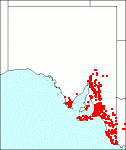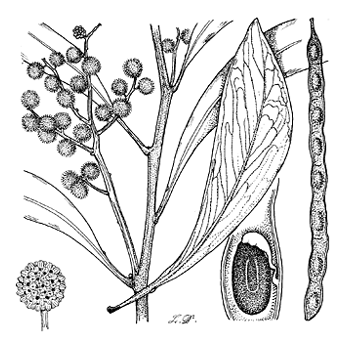Family: Fabaceae
Acacia pycnantha

Citation:
G. Bentham, Hook. Lond. J. Bot. 1:351 (1842).
Derivation: pyknos (Gr.), dense; anthos (Gr.), a flower. Synonymy: A. petiolaris Lehm., Delect. Sem. Hort. Hamburg. 1851: 7 (1851); A. falcinella Meissner, Bot. Zeit. 13:11 (1855)., Acacia leiophylla Common name: Golden wattle
Description:
Glabrous, medium-sized shrubs or small trees about 4-8 m high; trunk short, 12-20 cm diameter; bark usually smooth but sometimes scaly or roughened at the base, dark brown, northern occurrences usually have a smooth whitish-grey bark; branchlets smooth, terete or nearly so. Phyllodes broad-lanceolate, oblanceolate, 6-20 cm long 5-50 mm broad, broadest above the centre, curved or falcate, coriaceous, glabrous, mid-vein prominent, lateral veins numerous conspicuous and fine, margins prominent and vein-like, apex obtuse or acute; glands situated on the upper margin, one near the base sometimes a second gland above the middle. Inflorescences axillary racemes, usually shorter than phyllodes or paniculate towards the ends of branchlets; flower-heads large, globular, golden-yellow, fragrant, 50-80-flowered; peduncles short, stout glabrous. Legumes linear, 5-12 cm long, 5-7 mm broad, more or less straight, firmly chartaceous, flat but raised over the seeds, margins slightly constricted between seeds. Seeds longitudinal in legume, ovoid-obloid; funicle short, thickened into a small aril.
|
|
Distribution:
|
This species occurs in the Eyre Peninsula (southern part), Yorke Peninsula, Flinders Ranges, Northern and Southern Lofty, Kangaroo Island, Eastern, Murray and the South-Eastern regions. Sometimes found in dense thickets in open forest with Eucalyptus obliqua, E. baxteri or in woodland with E. camaldulensis, Casuarina stricta through to open scrub formation. Soils: on a variety of soils mainly hard acidic or neutral yellow duplex, hard alkaline red duplex or shallow calcareous loamy soils of the Flinders Ranges. Rainfall 350-1 200 mm. Also N.S.W., A.C.T. and Vic.
S.Aust.: FR, EA, EP, NL, MU, YP, SL, KI, SE.
|
Flowering time: August — October. |

SA Distribution Map based
on current data relating to
specimens held in the
State Herbarium of South Australia
|
Biology:
No text
Related taxa:
In South Australia Acacia leiophylla was previously often confused with and not distinguished from A. pycnantha (see Maslin and Whibley 1977). The two species can be found growing together mainly in the southern coastal regions. Acacia gillii from Eyre Peninsula region (southern part) is allied to golden wattle but has much narrower phyllodes and a different habit. A. saligna is closely related and differs in the thinner raceme axis and peduncles and phyllode base not so prominently tapered.
Taxonomic notes:
Only one collection of mistletoe Amyema preissii has been recorded on A. pycnantha. It is possible that the relatively short life span of this species may account for the absence of mistletoes.Leaf loss and gain of A. pycnantha was studied by Maconochie (1975). The plants were in the vicinity of the Para Wirra Reserve, Mt Lofty Range. Peaks of leaf production and loss occurred in the spring (October to December) and followed flowering with long steady states lasting about nine months. The floral buds of A. pycnantha are produced every month of the year on new shoot growth, Buttrose et al. (1981) and those formed between November and May developed through to flowering. The buds produced between June and October aborted at an early stage. Differences in the rate of floral development caused buds produced months apart to flower at the same time in late winter. The abortion of buds corresponded to the period of pod development thus a competition for metabolites could have been one of the causes of low floral development during this period. An experiment on the germination of Acacia pycnantha was described by Harding (1940). Treatments consisted only of boiling and/or soaking for different periods. Boiling for 5 seconds was more effective than for 2 minutes and both were better than no treatment. There was no interaction with a period of soaking. Once upon a time A. pycnantha was the basis of a Wattle bark industry in South Australia, Maiden (1906). The industry is now extinct. Yields and analyses for South Australia are given and the local bark is described as "one of the richest tanning barks in the world". Ford & Forde (1976) point out that nectar is apparently produced from the petiolar glands only when the plant is flowering and only on petioles close to the flowers. Honeyeaters and silvereyes take the nectar and brush against the flowers and could effect pollination. Insects visiting the glands would not effect pollination but could be a further attraction for the birds. Acacia pollen has been found on the feathers of some birds but not in great amounts. The nectaries do not appear to attract ants to protect against herbivorous insects as they do in the swollen-thorn Acacia of Central America. In a more extended study of bird pollination and nectar secretion Vanstone & Paton (1988) confirmed the initial observations of Ford & Forde (1976). A. pycnantha secreted extra-floral nectar during the winter and this coincided with flowering rather than the period of herbivore damage to the phyllodes. Phyllodes with axillary floral racemes or those nearer the tips of the branches were more likely to secrete nectar. At least 12 species of birds, including honeyeaters, thornbills and silvereyes, consumed the nectar and in the process brushed against the flowers. When birds were excluded from the flowers by mesh, pod production was significantly reduced although natural rates of pod production were low and variable. Some insects, flies, honeybees and ants, also visited the nectaries but did not contact flower-heads. Pollen harvesting insects were never common on the flowers but do occur. As A. pycnantha is largely self-incompatible it needs pollen transfer to set seeds. Bees however may be less reliable than birds due to reduced activity in cold weather. In these tests less than 1% of individual flowers and 70% of flower-heads failed to produce pods. Almost all phyllodes on the plants studied showed some herbivore damage. About 20% of the phyllodes were classified as highly damaged (i.e. had lost more than 20% of their surface). Little or no damage occurred during the flowering season most being done during late spring and summer during the period of active growth. If nectar flow has a protective function one could expect it to occur during this period. The three native bees foraging on A. pycnantha flowering in Victoria were studied by Bernhardt & Walker (1984). Most carried Acacia pollen but virtually all also carried pollen from other genera. Bees tended to prefer A. pycnantha to A. myrtifolia whose flowering overlapped. Bees did take secretions from the extra-floral nectaries as well as foraging for pollen. The secretions of A. pycnantha are depauperate in sucrose and are a minor source of bee sugars. A. pycnantha is a food plant for the larvae of several butterflies including Hypochrysops ignita, Jalmenus icilius, J. lithochroa and Theclinesthes miskini, Fisher (1978). A. pycnantha is locally established in the Cape Province of South Africa, Ross (1975a). It is also locally established in southern Europe. The leaves of A. pycnantha have been used to dye wool a golden colour using an alum mordant, Martin (1974). An account of A. pycnantha as the national floral emblem of Australia is given by Boden (1985). A Wattle Club of Victoria was founded in 1899 to promote Wattle Day. Acacia was introduced to Australian armorial bearings 1908-1912 and the ball of flowers was basic to the design of the Order of Australia honours and awards established in 1975. The unofficial national colours particularly for international sporting events are green and gold based on wattle foliage and flowers. Early stamps showing a wattle were not based on A. pycnantha but probably A. mearnsii or A. decurrens. Wattle has been used on other stamps. Amongst the latter was a set designed by Margaret Stones, botanical artist, one of which featured golden wattle and was issued in 1970.
Cultivation:
Well known in cultivation for many years. It is an attractive free-flowering species with large golden fragrant heads. It is adaptable to a variety of soil types and can be grown in near-coastal to inland semi-arid areas. It is somewhat sensitive to frost. Fast growth rate, but rather short lived. The bark is a well-known source of tannic acid.
Author:
Not yet available
Source:

|

